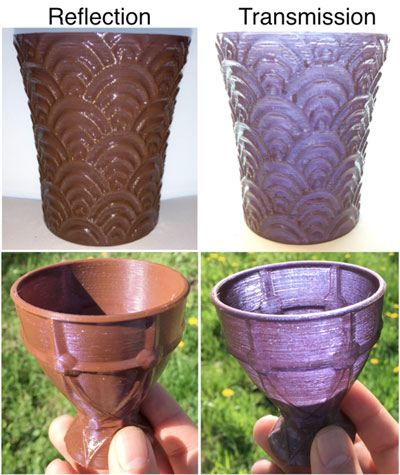| Feb 14, 2019 | |
3D printed nanomaterial shows different transparencies and colors (w/video)(Nanowerk News) Metallic nanoparticles have been used as glass colorant since the Roman Empire. One of the most famous piece of pottery from the Roman Empire is the Lycurgus cup. The nanoparticles embedded in this cup have an optical peculiarity as they present different colours depending by the angle of the illumination. This effect is called dichroism. |
|
| Now, scientists from Wageningen University & Research have 3D printed objects showing dichroic effect (Beilstein Journal of Nanotechnology, "Gold nanoparticles embedded in a polymer as a 3D-printable dichroic nanocomposite material"). | |
| This 21th century invention was possible by synthesising special kind of gold nanoparticles with different sizes. Those nanoparticles were then embedded in a common 3D printing material (PVA), available in any shop and 3D print it with a standard, off the shelf 3D printer. | |
A bit of gold |
|
| The amount of gold in the material is minute, a mere 0.07 weight percent. Such small amount of gold doesn’t change the printability of the material, which remain the same of the normal material. | |
| However, even at this low amount of gold, the nanocomposite material shows a distinct dichroic effect showing a brown opaque colour in reflection (when the illumination and the observer are on the same side) and a violet transparent colour in transmission (when the illumination and the observer are on the opposite sides). | |
 |
|
| The same 3D printed dichroic nanomaterial shows different colours and opacities when the light is from the same side of the observer (reflection) or on the opposite side (transmission). (Image: University of Wageningen) | |
New class of 3D printable nano materials |
|
| The material used in this new research is a standard material that can be printed with any off the shelf 3D printer and it opens the doors to a new class of 3D printable nano materials where the intrinsic properties of the nano world, in this case optical properties, are retained even in 3D printed object. Such peculiar optical properties can be used not only by artists for their colours, but in the future also for nanocomposite based lenses and filters. | |
| The researchers are now working on improving this methodology using different nanoparticles and different materials. |
| Source: Wageningen University | |
|
Subscribe to a free copy of one of our daily Nanowerk Newsletter Email Digests with a compilation of all of the day's news. |
